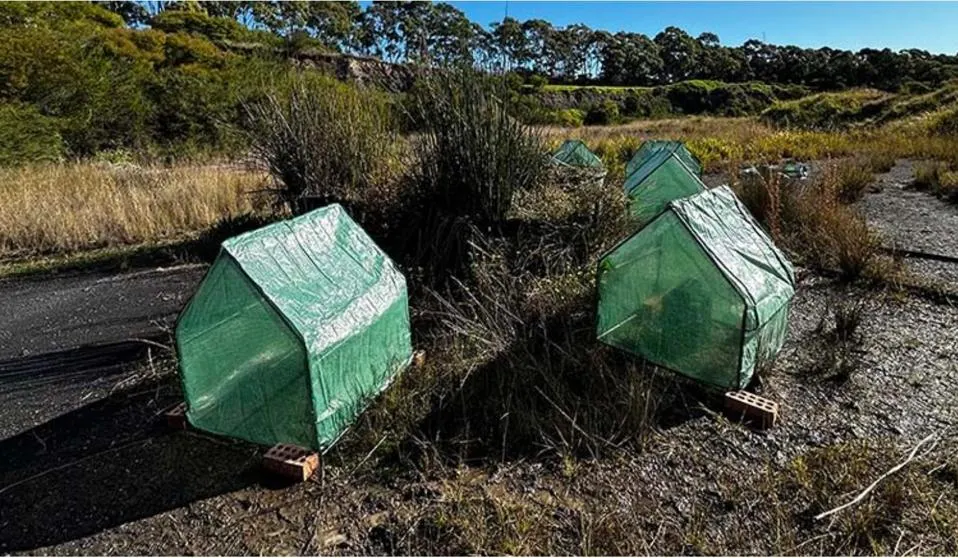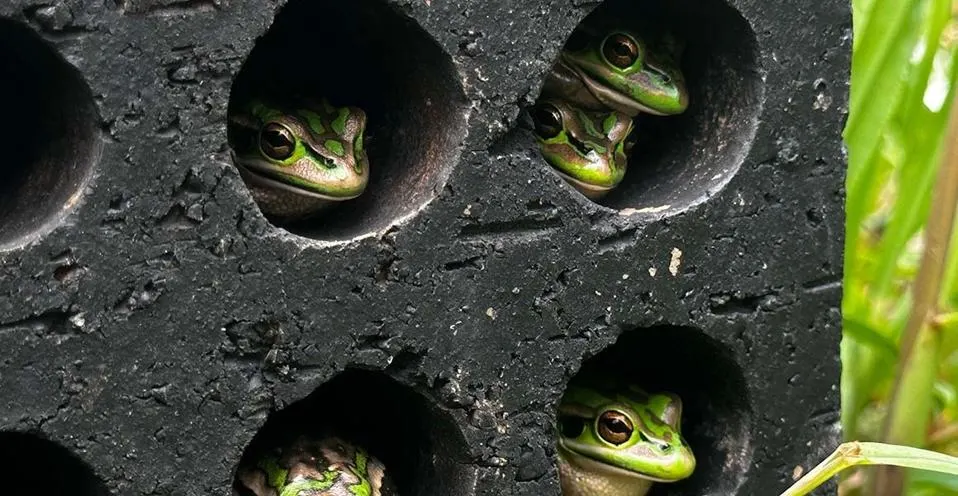Amphibian species worldwide are threatened with extinction by the deadly fungal disease, chytridiomycosis. Researchers have found a simple, low-cost way to help frogs fight off this infection: black bricks.
The Solution: Black Bricks
Black bricks might be the answer to the chytridiomycosis pandemic, which has been killing amphibian populations for decades. This disease is caused by chytrid fungi, Batrachochytrium dendrobatidis and Batrachochytrium salamandrivorans, which spread globally through the pet trade.
While several treatments have been tried, including fungicides and probiotic bacteria, these aren’t always effective for wild populations. Now, researchers at Macquarie University and the University of Melbourne have found a very simple, inexpensive solution: a ‘frog sauna.’
How It Works
The ‘frog saunas’ are made from 10-hole masonry bricks painted black and housed in PVC greenhouses. Infected frogs can take refuge in the small holes in the bricks, where their body temperatures can reach 30°C, enough to kill chytrid fungi, which stops growing at around 82°F and dies at 86°F (30°C).

“This is really exciting,” said Anthony Waddle, the study’s lead author. “In these simple little hotspots, frogs can go and heat up their bodies to a temperature that destroys the infections.” He likened the saunas to “a mini med spa for frogs.”
The Deadly Impact of Chytridiomycosis
Chytridiomycosis is the deadliest wildlife pathogen known, causing massive declines in amphibian populations worldwide. It has been linked to the extinction of 90 amphibian species and the decline of 491 others.
The fungus infects the skin of amphibians, interfering with water and mineral uptake and respiration, eventually leading to cardiac arrest. Tadpoles carry the fungus until they metamorphose, at which point they die.
The Green and Golden Bell Frog
One of Australia’s endangered amphibians is the green and golden bell frog, which has suffered from habitat loss, invasive species, and chytridiomycosis. These frogs are now globally endangered.
Dr. Waddle and his team found that green and golden bell frogs prefer basking at 29°C, perfect for killing chytrid fungi. When infected frogs were allowed to bask at this temperature, the fungus was cleared from their skin in just six days.
In further tests, frogs that recovered from the infection were more likely to survive subsequent exposures, indicating they developed some immunity.
Practical Applications
The team tested their findings in outdoor mesocosms, finding that frogs in sunnier environments had significantly reduced infection rates. This simple intervention could help reduce the impact of the chytrid pandemic on amphibians.
“As scientists, we always think ‘it’s not going to work,’” Dr. Waddle said — so he was surprised and excited to see just how unambiguous the results were. But how lasting were these effects?
“Frogs that had cleared their infection using heat were subsequently resistant to disease regardless of their body temperature,” Dr. Waddle reported. “This allowed me to think of the shelters as these little factories where sick frogs would go, get better, and come out not only healthy but better able to fight chytrid.”
Frog Populations and Warm Refuge
Interestingly, this isn’t the first time that warm places of refuge have helped frog populations survive chytrid infections. A 2011 study found that two seemingly extinct species survived by perching on sun-warmed boulders in a waterfall clearing, staying healthy and chytrid-free.
This led some to suggest clearing trees around ponds or heating pond water to help infected frogs, but warmed bricks in greenhouses offer a more elegant and cheaper solution.
“In the 25 years since chytrid was identified as a major cause of the global collapse of amphibian populations, our results are the first to provide a simple, inexpensive and widely applicable strategy to buffer frogs against this disease,” Dr. Waddle explained.
The study’s senior author, Professor Rick Shine, noted that this study has developed a simple targeted intervention that can be easily scaled up, potentially helping reduce the impact of the deadly chytrid pandemic on the world’s frogs and toads.
“Chytrid isn’t going away,” Professor Shine remarked, “but our behavioral ecology intervention can help endangered amphibians co-exist with chytridiomycosis in their ecosystems.”
Acquired Immunity
Dr. Waddle, Professor Shine, and collaborators also found that frogs who survive a chytrid infection can develop a form of acquired immunity, making them more resistant to future infections.
“Lowering mortality rates and boosting their immunity to chytrid is the key to protecting amphibians from this disease, which is now endemic around the world,” Dr. Waddle explained.
Most of the surviving green and golden bell frog populations live on private land in Australia, complicating conservation efforts. However, constructing ‘hotspot’ shelters is practical and easy using inexpensive materials, according to Dr. Waddle. Frog saunas might also help other frog and toad species.
“This research has great potential to be extrapolated to other endangered frog species threatened by chytridiomycosis,” said co-author Lee Skerratt, a wildlife epidemiologist at the University of Melbourne.
Conclusion
Although saunas might not be a cure-all for all frog species, they provide a valuable tool for fighting chytrid infections, especially during colder seasons. Dr. Waddle plans to roll out these frog saunas across Sydney and hopes to see them used on a larger scale.
“Eventually, I would like to place the shelters at all of the major priority areas for the species,” Dr. Waddle continued. “Since the shelters are inexpensive and made from readily available materials, I am also keen to see the general public get involved with their deployment.”
“I have drafted a how-to guide for constructing a shelter and my hope is that people living on Australia’s central coast may take an interest in the frogs and place these in their backyards.”

